
home I index I latest I glossary I introductions I e-mail I about this site
St Catherine, Norwich
Read
the captions by hovering over the images, and click on them to
see them enlarged.
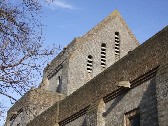
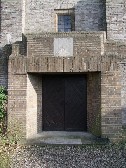
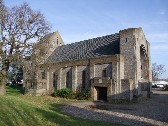
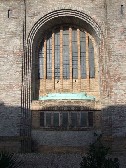
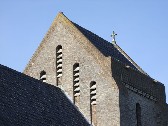
St
Catherine, Norwich
St Catherine captures the spirit of its age as well as any of Norwich's generally excellent 1930s buildings. The first sign of this comes as you come through the heavy, studded doors of the neo-Norman south entrance, and are faced with jaunty black leatherette inner doors with round portholes, as if we were in a cinema or on board a ship. This motif is repeated throughout the building. As you would expect, the building you enter is full of light, with the wooden floors and white walls typical of the 1930s, but there is also the huge delight (and you might have got an inkling of this from the doors) of the Art Deco furnishings, particularly the magnificent lamps which hang beneath the rather incongruous texts along the wall plate to the ceiling. The original hard wooden chairs have been replaced with modern blue ones, which successfully reflect the blue undersides of the neo-Norman archways. While the Art Deco is not as complete in this church as in its exact contemporary Ipswich All Hallows, Caroe successfully combined it with older motifs, which speak of the Anglican triumphalism of a decade earlier. The most striking of these is the huge stone reredos carved with scenes from the life of Christ. The lines of Art Deco lamps lead the eye to it, and it seems rather incongruous set beyond the clean lines of the wooden singers gallery. The thin lancet above depicts Christ in Majesty with St Catherine and St Felix, and is very much in the style of the William Morris workshop, although the artist was apparently one Hubert Blanchford. At the opposite end of the church is a fine western gallery, with the curiosity of two separate sets of Royal Arms, one those of George the Fifth, and the other apparently the standard of Queen Mary, who opened the building. One of the privileges of this site is that I sometimes get to go behind the scenes, so to speak, and it was with excitement that I climbed up the spiral staircase to the top of the church. This is a perfect 1930s moment, a nautiloid stairway, falling away beneath and giving the effect of climbing up the inside of a giant snail shell. At the top I walked through the long attic which runs the length of the building, the grills in the floor giving disconcerting glimpses of the church floor some forty feet below. At the far end I entered St Catherine's stubby tower, and here is the delightful sight of what is, surprisingly enough, the oldest set of bells in the city. They came from the redundant church of St Mary Coslany. They are suspended from the beam, and struck by hammers operated from pulley ropes below, but I can't help thinking that there would be room within this space for a bell cage so that they could be rung properly again. |
Simon Knott, July 2009, updated May 2010
Amazon commission helps cover the running costs of this site.
home I index I latest I introductions I e-mail I about
this site I glossary
Norwich I ruined churches I desktop backgrounds I round tower churches
links I small
print I www.simonknott.co.uk I www.suffolkchurches.co.uk